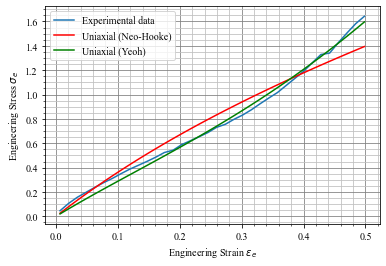Hyperelastic formulations using an algorithmic differentiation with hyper-dual numbers in Python
Project description

HyperMAT
هايبرمات
Hyperelastic formulations using an algorithmic differentiation with hyper-dual numbers in Python.
HyperMAT is based on the definitions of the first Piola-Kirchhoff stress $\large P$ and the tangent modulus $\large \hat{A}$ given below:
$\large P = \frac{\partial{W}}{\partial{F}}$
$\large \hat{A} = \frac{\partial^2{W}}{\partial{F}^2}$
How to use
This is a quick example of how to use:
import numpy as np
import hypermat as hm
# Initialise material
umat = hm.NeoHooke(C10=0.5, K=0)
# Initialise deformation gradient values
np.random.seed(125161)
F = (np.eye(3) + np.random.rand(50, 8, 3, 3) / 10).T
# Get stress tensor
P = umat.jacobian(F)
# Get tangent modulus tensor
A = umat.hessian(F)
Sometimes a lucky engineer will have some tension or compression stress-strain test data, or simple shear test data. Processing and applying these data is a critical step to analyze the hyperelastic models. HyperMAT has a calibration module that can help to get the best fitted model parameters. Let's take a look on how are things going on:
import os
from hypermat import NeoHooke, Yeoh, read_file, to_dict, Uniaxial
#Prepare material models
umat1 = NeoHooke(C10=1.5,K=2000)
umat2 = Yeoh(C10=0.5,C20=-0.01,C30=0.2, K=2000)
#Prepare experimental data
dir_path = os.path.dirname(os.path.realpath(__file__))
dataset = read_file(dir_path+'//_data//_data_2.csv', delimiter=',', dtype=float)
data = to_dict(dataset[1:,:], ['time', 'strain', 'stress'])
strain = data['strain']
stress = data['stress']
#Choose loading type (Uniaxial, Biaxial or Shear)
test1 = Uniaxial(umat1, data)
test2 = Uniaxial(umat2, data)
#Plot experimental data
test1.plot()
#Fit parameters
test1.fit_data([0,0],[20,2000],[True, False])
test2.fit_data([0,-20,-20,0],[20,20,20,2000],[True,True,True, False])
#Plot results
test1.plot_model(c='r')
test2.plot_model(c='g')
You should get something like that:

HyperMAT fitted parameters
{'C10': 0.6624343754510106}
{'C10': 0.5903745146776757, 'C20': -0.09056730756209555, 'C30': 0.3065185192428228}
MCalibration fitted parameters
{'C10': 0.623489155}
{'C10': 0.585555703, 'C20': -0.0846386036, 'C30': 0.304613717}
A special thank you goes to Dutzler, for providing us many powerful tools such as TensorTrax and hyperelastic.
License
HyperMAT- Hyperelastic formulations using an algorithmic differentiation with hyper-dual numbers in Python, (C) 2023 Mohamed ZAARAOUI, Tunisia.
This program is free software: you can redistribute it and/or modify it under the terms of the GNU General Public License as published by the Free Software Foundation, either version 3 of the License, or (at your option) any later version.
This program is distributed in the hope that it will be useful, but WITHOUT ANY WARRANTY; without even the implied warranty of MERCHANTABILITY or FITNESS FOR A PARTICULAR PURPOSE. See the GNU General Public License for more details.
You should have received a copy of the GNU General Public License along with this program. If not, see https://www.gnu.org/licenses/.
Project details
Release history Release notifications | RSS feed
Download files
Download the file for your platform. If you're not sure which to choose, learn more about installing packages.














